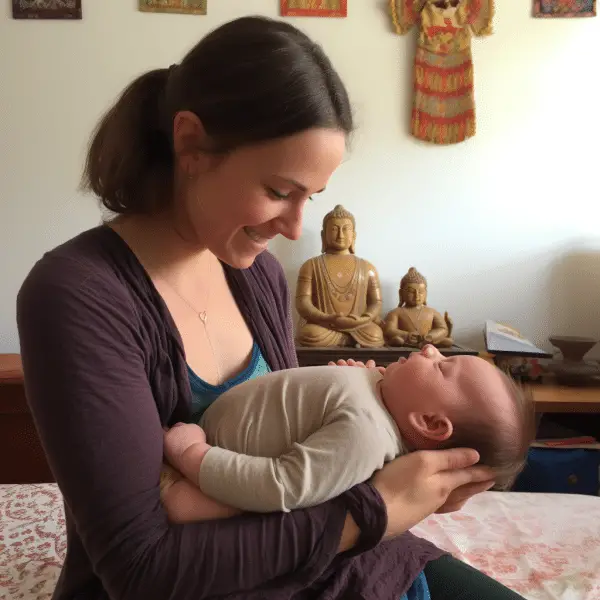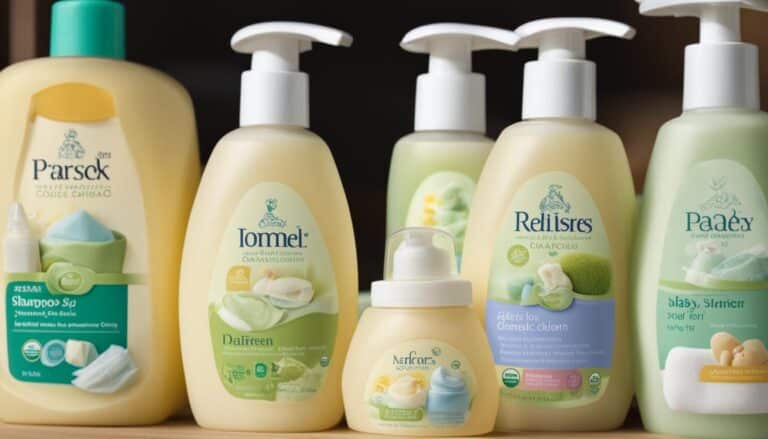Infant Massage for Bonding and Development
Infant massage is an incredible opportunity for parents to bond with their babies on a deeper level. It goes beyond the physical act of touch and fosters an emotional connection that lays the foundation for healthy growth and development. Through the power of massage, parents can communicate love, care, and affection to their little ones, promoting a sense of security and enhancing overall well-being.
Key Takeaways:
- Infant massage strengthens the bond between parents and their babies.
- It promotes emotional connection and helps in healthy growth and development.
- Through massage, parents can communicate love and care to their little ones.
- Infant massage provides a sense of security and enhances overall well-being.
- The benefits of infant massage go beyond the physical act of touch.

The Benefits of Infant Massage
Infant massage offers numerous benefits for both the baby and the caregiver. It is a powerful tool for bonding and promoting the physical and emotional growth of the baby. Through gentle and loving touch, parents can create a strong emotional connection with their little ones, laying the foundation for a healthy relationship.
One of the key benefits of infant massage is relaxation. The soothing strokes and rhythmical movements help calm the baby’s nervous system, reducing both emotional and physical stress. This can lead to improved sleep patterns and a more contented baby.
Infant massage facilitates nutrient absorption by applying gentle pressure and stimulating the digestive system. Improved blood circulation enhances digestion, making it especially helpful for babies with colic or digestive problems.
Infant massage is a holistic method nurturing a baby’s development. It fosters bonding, stimulates physical and emotional growth, promotes relaxation, reduces stress, and improves food absorption. This practice empowers caregivers to provide loving touch and care for their little ones.
The Importance of Touch and Bonding
Babies in modern society often lack sensory and emotional stimulation due to excessive use of containers like car seats and strollers. This touch deprivation can result in fussy babies without positive physical touch, impacting bonding and nervous system development. Close contact and intimate touch offer security, helping infants recognize their parent’s scent and touch, leading to a calmer nervous system.
Research emphasizes the importance of touch for babies’ overall well-being. Cuddling, hugging, and gentle massages have a profound impact on emotional and physical health. These positive touches create a strong bond between the baby and caregiver, offering essential sensory and emotional stimulation crucial for growth.
“Touch has a memory.” – John Keats
Bonding through touch is a natural process practiced globally for centuries. “Skinship” or kangaroo care, exemplifies the power of touch in fostering positive parent-baby connections, offering benefits like accelerated growth, improved development, reduced crying, better sleep, and enhanced self-regulation.
| Benefits of Skin-to-Skin Contact | Examples |
|---|---|
| Improved physiological and neurological development | Practiced in Japan |
| Reduced crying and better sleep | Practiced in Colombia |
| Enhanced self-regulation and overall well-being | Practiced in various cultures worldwide |
By understanding the importance of touch and bonding, caregivers can make conscious efforts to provide their babies with positive physical touch and sensory stimulation. Whether it’s through simple acts of cuddling, baby massages, or incorporating skin-to-skin contact into daily routines, nurturing touch can contribute to the overall well-being and development of the baby.
Cultural Examples of Skin-to-Skin Bonding
In certain cultures, skin-to-skin contact is highly valued and practiced as a way to enhance the bond between parent and baby. Let’s take a closer look at two cultural examples where skin-to-skin contact, often referred to as “SKINSHIP,” is an integral part of caregiving.
Kangaroo Care in Colombia
It is prevalent in Colombia. Kangaroo care is skin-to-skin contact with a premature or low-birth-weight newborn on the parent’s chest. This practice helps regulate temperature, normalize heart and breathing rhythms, boost breastfeeding, and strengthen parent-baby bonds.
Studies demonstrate that babies who receive kangaroo care grow quicker, develop better physiologically and neurologically, and are less likely to get infections or respiratory distress. Close physical touch and constant parental presence assist babies manage their body temperature and self-regulate, improving health and development.
Skinship in Japan
Japan values parent-child “skinship” through close physical contact. Infants feel secure, emotionally healthy, and cognitively developed through skinship. Japanese parents strengthen bonds through infant massage, bathing, and skin-to-skin contact.
Skinship and close physical touch help Japanese infants grow and develop, according to research. It reduces crying, improves sleep, and boosts physiological and neurological development. Skinship helps parents identify and meet their baby’s needs, increasing self-regulation and well-being.
Both kangaroo care in Colombia and skinship in Japan emphasize the importance of skin-to-skin contact for babies’ physical, emotional, and cognitive development. These cultural examples demonstrate the favorable effects of close physical contact on parent-child relationships.
| Cultural Example | Baby Benefits |
|---|---|
| Kangaroo Care in Colombia | Improved temperature regulation, stabilized heart and breathing rates, increased breastfeeding success, enhanced bonding, faster growth, better physiological and neurological development |
| Skinship in Japan | Less crying, better sleep, improved physiological and neurological development, recognition and response to baby’s needs, self-regulation |
Massage and Brain Development
Massage plays a crucial role in stimulating the myelination process in the brain and nervous system, promoting healthy development in infants. Myelination involves the formation of a fatty covering around nerves, allowing for rapid transmission of impulses between the brain and the rest of the body. This process enhances overall brain-body communication and supports cognitive development.
Through regular massage, the repetitive and rhythmic movements help stimulate rapid neural-cell firing, which further strengthens the connections in the infant’s developing brain. This increased neural activity contributes to improved cognitive abilities and overall brain function.
The Relationship Between Massage and Myelination
The benefits of myelination extend beyond the brain. The nervous system, which is responsible for transmitting messages throughout the body, also benefits from massage-induced myelination. The enhanced transmission of impulses improves the infant’s ability to process sensory information, enhancing their overall understanding of the world.
In the words of Dr. Sandra Black, a renowned neurologist, “Massage provides not only a soothing and relaxing experience but also supports the development of healthy neural connections in the brain, creating a strong foundation for future learning and cognitive development.”
Communication and Brain Development
Massage not only stimulates myelination but also plays a vital role in fostering communication skills in infants. The loving touch and physical interaction between caregiver and baby during massage sessions create opportunities for connection and bonding. These experiences help the infant develop a sense of trust and security and facilitate the development of social and emotional intelligence.
The Science of Pleasant Touch
Research has shown that pleasant touch has a significant impact on babies, affecting their heart rate and physiological arousal. When caregivers provide gentle, medium-velocity touch, infants experience a decrease in their heart rate, indicating a calming effect. This highlights the importance of caregiver sensitivity when it comes to touch and the strong bond it can foster between the caregiver and the baby.
“The more sensitive a caregiver is to touch, the more the infant’s heart rate slows in response to medium-velocity touch.”
From an early age, babies are sensitive to touch, and it plays a vital role in human social interactions. By recognizing and responding to their baby’s cues through pleasant touch, caregivers can establish a deep connection and create a sense of security for the infant.
The science of pleasant touch also underscores the reciprocal nature of the caregiver-infant relationship. When a caregiver engages in gentle touch, it not only calms the baby but also elevates the caregiver’s oxytocin levels, strengthening the bond between them. This reciprocal interaction during pleasant touch sets the stage for nurturing social interactions and emotional development.
The Importance of Caregiver Sensitivity
Caregiver sensitivity is key when it comes to providing pleasant touch to infants. It involves being attuned to the baby’s signals and responding with care and gentleness. By being sensitive to touch, caregivers can create an environment that promotes the baby’s emotional well-being and supports healthy social interactions.
- Pay attention to the baby’s cues: Babies communicate their needs through various cues, including facial expressions, body language, and vocalizations. By observing these cues, caregivers can understand when their baby is receptive to touch and when they may need a break.
- Use gentle, soothing strokes: When providing pleasant touch, caregivers should use gentle, soothing strokes that match the baby’s natural rhythms. This helps create a calming environment and promotes relaxation for both the baby and the caregiver.
- Respect the baby’s boundaries: It is important for caregivers to respect the baby’s boundaries during pleasant touch. If the baby shows signs of discomfort or agitation, caregivers should adjust their touch or take a break. This builds trust and fosters a sense of safety for the infant.
Overall, understanding the science behind pleasant touch and practicing caregiver sensitivity can have profound effects on both the baby and the caregiver. By providing gentle, medium-velocity touch and being attuned to the baby’s cues, caregivers can enhance the bond with their infant and contribute to their healthy development.
| Heart Rate Decrease with Medium-Velocity Touch | Heart Rate Increase with Fast Touch |
|---|---|
| 10% decrease in heart rate | 10% increase in heart rate |
| Calming effect | Stimulating effect |
The Holistic Benefits of Infant Massage
Infant massage is a holistic process that goes beyond mere physical touch. It is a non-invasive therapy that nurtures the whole baby, addressing their physical, emotional, and cognitive development. Through infant massage, caregivers can build a bond with their baby based on trust and respect, creating a foundation for healthy relationships.
One of the key benefits of infant massage is its ability to promote relaxation and improve sleep. The gentle and rhythmic strokes used during the massage help calm the baby, easing any tension or discomfort they may be experiencing. As a result, infants who receive regular massages often have better sleep patterns, leading to more restful nights for both the baby and the caregiver.
Furthermore, infant massage can provide relief from common digestive issues such as gas and colic. The massage strokes help stimulate the baby’s digestive system, aiding in the movement of food through the digestive tract. This can alleviate discomfort and reduce episodes of fussiness or crying. By addressing these physical needs, infant massage contributes to the overall well-being of the baby.
Table: Comparing the Holistic Benefits of Infant Massage
| Physical Benefits | Emotional Benefits | Cognitive Benefits | |
|---|---|---|---|
| Improved Sleep | Relaxes muscles and promotes deep sleep | Enhances emotional regulation and reduces anxiety | Enhances brain development and cognitive processing |
| Relief from Digestive Issues | Stimulates digestion and relieves gas or colic | Provides comfort and reduces irritability | Improves focus and cognitive functioning |
| Enhanced Bonding | Strengthens the caregiver-infant relationship | Creates a sense of security and trust | Promotes social and emotional intelligence |
By engaging in regular infant massage, caregivers can provide their baby with a nurturing and loving environment. The holistic benefits of this practice extend far beyond the physical, encompassing emotional well-being, cognitive development, and the establishment of a strong bond based on trust and respect. Infant massage truly empowers caregivers to be active participants in their baby’s growth and development.
The Infant Massage Program
Infant Massage USA’s comprehensive program stimulates organ systems, encourages caregiver-baby communication, relaxes through massage strokes, and relieves gas, colic, and discomfort. To deliver comprehensive infant massage, the program draws from Indian head massage, yoga, Swedish massage, and reflexology.
Through stimulation, interaction, relaxation, and relief, caregivers can create a nurturing environment that promotes the overall well-being of their baby. By stimulating the organ systems, massage helps improve circulation, digestion, and respiration. This stimulation supports the healthy growth and development of the baby’s body. Additionally, interactive communication during the massage enhances the bond between caregiver and baby, fostering emotional connection and promoting social development.
Massage strokes soothe the baby and caregiver, improving sleep and stress. This relaxation is essential for the baby’s physical and emotional well. Massages also relieve gas and colic, making babies happier and more comfortable. Infant Massage USA’s structured and thorough program helps caregivers provide the greatest care for their babies.
| Benefits of the Infant Massage Program: |
|---|
| Stimulation of organ systems |
| Interactive communication |
| Relaxation through massage strokes |
| Relief from gas, colic, and discomfort |
The Infant Massage Training Process
Infant massage training is a structured and educational process that empowers caregivers to confidently perform massage on their babies. The training typically consists of five sessions, each lasting between 30 minutes to 1 hour. During these sessions, caregivers learn the purpose and benefits of infant massage, as well as essential techniques and gentle movements.
The training emphasizes a baby-led experience, where caregivers ask for permission before massaging. Open communication and understanding between caregiver and baby are promoted by this technique.
The training helps caregivers recognize and analyze their baby’s response. Verbal cues, body language, and behavior changes might provide feedback. Caregivers’ feedback helps adapt massages to babies’ requirements, providing a safe and happy session.
A review of skills and gentle movements to soothe the infant and caregiver conclude the course. Carers learn vital skills that help them bond with their babies through infant massage training.
Benefits of Infant Massage Training
Infant massage training provides numerous benefits for both the caregiver and the baby. Some of these benefits include:
- Enhanced bonding and attachment between the caregiver and the baby
- Promotion of healthy growth and development
- Improved communication and understanding of the baby’s needs
- Reduced stress and relaxation for both the caregiver and the baby
- Relief from common discomforts such as gas and colic
Overall, infant massage training offers caregivers the opportunity to develop a deeper connection with their baby while promoting their well-being and development.
| Benefits | Description |
|---|---|
| Enhanced Bonding | Infant massage training facilitates a stronger bond and attachment between the caregiver and the baby, promoting a sense of security and trust. |
| Promotes Development | Through massage, caregivers stimulate the baby’s development across various aspects, including physical, emotional, and cognitive. |
| Improved Communication | Infant massage training helps caregivers recognize and interpret their baby’s cues, fostering effective communication and understanding. |
| Reduced Stress | Both the caregiver and the baby experience reduced stress levels through the soothing and relaxing nature of infant massage. |
| Relief from Discomfort | Massage techniques taught during the training can provide relief from common discomforts such as gas and colic, promoting overall comfort for the baby. |
Conclusion
Infant massage fosters bonding, emotional connection, and healthy development between parents and babies. The holistic approach brings physical, emotional, and cognitive benefits to the newborn, establishing a profound connection and trust through massage.
Caregivers empower themselves as experts on their child through the delicate touch of infant massage. This technique stimulates organ systems, promotes relaxation, and enhances the bond between caregiver and infant. Positive interactions built through massage extend throughout the child’s life.
Structured infant massage training sessions educate caregivers on the purpose and benefits of massage, fostering an awareness of their baby’s needs. Respecting cues and feedback, caregivers provide a tailored, nurturing massage experience. The program integrates various massage techniques for a comprehensive approach.
In summary, infant massage is an empowering practice nurturing emotional connection, healthy growth, and overall development. It provides caregivers a meaningful bonding experience while promoting relaxation. This holistic approach establishes a strong foundation for the baby’s well-being and future relationships, fostering a lifetime of love and connection.
FAQ
What is infant massage?
Infant massage is a technique where parents use their hands to gently stroke, caress, and manipulate their baby’s body. It is a way to provide loving touch and enhance the bond between parent and baby.
What are the benefits of infant massage?
Infant massage offers numerous benefits, including increased bonding and interaction, stimulation of physical and emotional growth, relaxation and relief, reduced stress, and improved food absorption.
Why is touch and bonding important for babies?
Touch and bonding are crucial for babies’ development. Positive physical touch promotes a sense of security, helps infants recognize their parent’s scent and touch, and leads to a calmer nervous system. This early sensory and emotional stimulation is essential for healthy growth.
Are there any cultural examples of skin-to-skin bonding?
Yes, in cultures like Japan and Colombia, skin-to-skin contact is practiced and has been shown to have numerous benefits. Babies who experience close physical contact grow faster, are healthier, cry less, sleep better, and have better physiological and neurological development.
How does infant massage support brain development?
Infant massage stimulates the myelination of the brain and nervous system, which enhances the development of the baby. Myelination is the process of coating the nerves with a fatty covering that speeds up the transmission of impulses. Massage supports rapid neural-cell firing, improving brain-body communication and overall cognitive development.
What is the science behind pleasant touch?
Research shows that babies respond positively to pleasant touch, which helps decrease physiological arousal and improve their bond with their primary caregiver. The more sensitive a caregiver is to touch, the more the infant’s heart rate slows in response to medium-velocity touch, creating a stronger connection between caregiver and baby.
How does infant massage benefit the whole baby?
Infant massage is a holistic process that supports the physical, emotional, and cognitive development of the baby. It stimulates organ systems, improves sleep, relieves discomfort, and provides relaxation. It empowers caregivers and encourages a strong bond built on trust and respect.
What is the Infant Massage Program?
The Infant Massage USA program emphasizes stimulation of organ systems, interactive communication between caregiver and baby, relaxation through massage strokes, and relief from discomfort. It draws inspiration from Indian head massage, yoga, Swedish massage, and reflexology to create a comprehensive approach to infant massage.
What does infant massage training involve?
Infant massage training typically consists of five structured sessions ranging from 30 minutes to 1 hour each. Caregivers learn about infant massage, its purpose, benefits, and the best oils to use. The training is baby-led, with caregivers asking for permission before administering the massage strokes. Throughout the sessions, caregivers receive guidance on recognizing and interpreting their baby’s feedback.
Why is infant massage important for bonding and development?
Infant massage is a powerful way to enhance bonding between parents and their babies. It offers numerous benefits for the overall growth and development of the baby, including physical, emotional, and cognitive aspects. The holistic approach of infant massage promotes a strong bond built on trust and respect, creating a foundation for healthy relationships throughout the child’s life.







